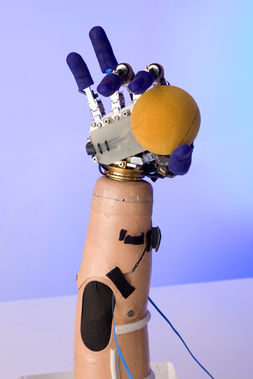2004 - Fluidhand 7
The Fluidhand 7 is designed as an experimental hand. It is used to develop new control methods and to test a new tank system that is capable of storing energy. The hand therefore has one valve for each of the 8 drives. A type of spring accumulator was developed for the hydraulic tank, which allows the hand to be closed quickly and silently without the hydraulic pump operating. Due to the large number of new and experimental components, the metacarpus has turned out to be significantly larger than the previous model, but at this stage of development, the anatomical shape and size of the hand is not a priority.
For the hydraulic system, experiments were carried out with a tank that allows energy recovery when the hand is opened. The tank consists of a rigid outer shell and an elastic tank bladder inside. Between the outer shell and the tank bubble is a two-phase gas under constant pressure of 2 bar. In the intermediate space, just enough gas is formed from the liquid aggregate state until a constant pressure is reached. When the hand is opened, gas is formed; when it is closed, it is compressed into liquid, at a constant working pressure of 2 bar at room temperature. The internal diaphragm with the hydraulic fluid is thus under the pressure of the gas. When a valve is opened, a finger joint is already moved without the hydraulic pump having been activated. The pump can then build up even greater grasping force with a time delay. In this way, very dynamic and also noiseless finger movements are possible. When the drives are emptied, the water is pressed back into the tank, against the pressure of the two-phase gas, and the system is ready for the next grasping process.









